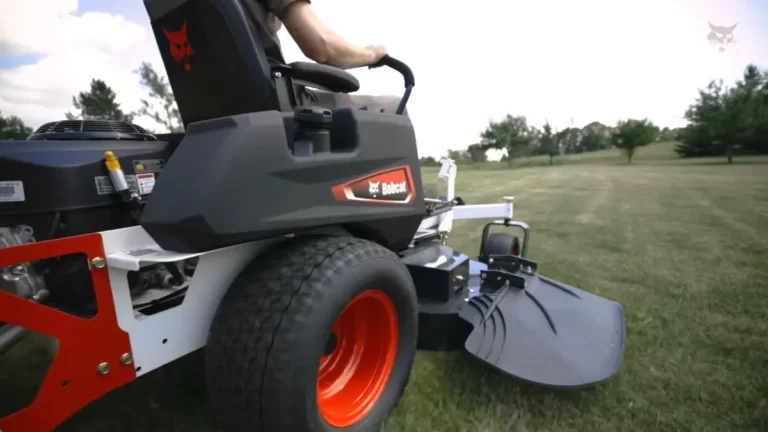Understanding Riding Mower Blade Direction: A Complete Guide
Proper mower maintenance is essential for achieving a well-manicured lawn. One crucial aspect of maintaining a riding mower is ensuring riding mower blade direction correctly.
Riding mower blades commonly rotate clockwise, ensuring efficient grass cutting for a tidy lawn. However, variations exist by make and model.
This article will explain why blade direction matters, how to determine the correct direction and how to operate your mower safely.

Which Way Does a Mower Blade Turn?
Understanding the direction in which the blade turns is also important for maintaining your lawn mower:
Clockwise Rotation:
When looking down on your deck from the operator’s station, the lawn mower blades turn clockwise.
This means that when the mower is in operation, the blades spin in a clockwise direction.
Advantages:
- Efficient for mowing tall or thick grass, providing a cleaner cut.
- Superior bagging performance, making it easier to collect grass clippings.
Disadvantages:
- May leave clumps of grass behind, especially in wet or long grass.
- Can result in an uneven cut on bumpy terrain.
Counter-Clockwise Rotation:
If you are working underneath your deck and looking at the blades from the bottom of your mower deck, the blades turn counter-clockwise.
Advantages:
- Better mulching capabilities, leading to faster decomposition and nutrient recycling.
- Provides a more even cut on uneven terrain.
Disadvantages:
- Reduced bagging performance, making it more challenging to collect clippings.
- Less effective for tall or thick grass, potentially resulting in an uneven cut.
Setting Riding Mower Blade Direction
Regardless of the blade rotation direction, here are some tips to help you achieve a pristine cut with your riding mower:
1. Determining Rotation Direction
- Check the mower’s instruction manual or visually inspect the blades.
- Clockwise rotation if cutting edge faces the ground, counterclockwise if it faces away.
2. Adjust Cutting Height
- Use the mower’s adjustment lever or knob.
- Ensure even adjustment for a uniform cut.
3. Blade Alignment
- Visually inspect and align the blades.
- Ensure they’re securely fastened to prevent loosening during operation.
Things To Consider About Riding Mower Blades Direction
When it comes to the direction in which mower blades turn, there are a few key points to consider.
Operator’s Perspective:
- Most lawn mower blades rotate in a clockwise direction when viewed from the operator’s perspective, which is when you are pushing or riding the mower.
- This clockwise rotation creates a powerful cutting action as the blades slice through the grass blades.
Underneath the Deck Perspective:
- When viewed from underneath the deck, the blades typically turn in a counter-clockwise direction.
- This counter-clockwise rotation is necessary for efficiently discharging the grass clippings out of the cutting deck and into the bag or side discharge chute.
Installation:
- If you have removed the lawn mower blade and need to reinstall it, there are a few methods to determine the correct orientation.
- One way is to observe the sharp side of each blade, which should be facing outward when installed.
- Additionally, some blades may have a curved lip, which should face up toward the mower deck when installed.
Why Does Riding Mower Blade Direction Matter?
The direction in which the blades of your riding mower rotate plays a significant role in the overall quality of your lawn’s appearance.
1. Grass Health
Proper blade direction ensures a clean, even cut, reducing stress on the grass and promoting healthy growth.
2. Appearance of the Cut
Mowing in the right direction provides a neater and more uniform finish, enhancing the overall look of your lawn.
3. Mower Performance
Using the correct blade direction reduces strain on the engine and blades, leading to smoother and more efficient operation, and ultimately extending your mower’s lifespan.
4. Efficiency in Mowing
Knowing the optimal blade direction saves time and effort, particularly beneficial for larger lawns or properties.
5. Visually Appealing Lawn
Implementing the right blade direction results in a well-maintained, aesthetically pleasing lawn, enhancing the overall ambiance of your outdoor space for you and your guests to enjoy.
Troubleshooting Common Blade Direction Issues
While maintaining your riding mower blades and following the correct blade direction will help keep your lawn in good condition, issues can still arise. If you’re experiencing problems related to blade direction, follow these troubleshooting steps:
Problem 1: Uneven Cutting
If your mower is leaving patches of taller or shorter grass, it’s possible that the blade height is uneven.

The Fix
In this case, try adjusting the cutting height to ensure the blades are at the same level.
Problem 2: Blades Spin in Reverse
If your mower’s blades are spinning in the opposite direction than they should, it’s likely that the blades are installed upside down.
The Fix
To fix this, remove the blades and inspect them carefully to determine which side should face upwards.
Problem 3: Blades Won’t Turn
If your mower blades won’t turn at all, it’s possible that a belt has slipped or is broken.
The Fix
Check the belts on your mower and replace them as necessary.
Problem 4: Blades Overheat
If you notice that your mower blades are overheating or smoking, it may be due to a buildup of debris around the blades.
The Fix
Carefully clean the blades and the surrounding area to remove any stuck-on grass or other debris.
Related Post: Fixing Riding Mower Blades Won’t Engage: A Simple Troubleshooting Guide
Frequently Asked Questions (FAQs)
What is riding mower blade direction?
Riding mower blades typically spin in a clockwise direction, promoting effective grass cutting and a well-kept lawn. Nevertheless, there can be differences depending on the mower’s make and model.
Why is correct blade direction important?
Using the correct blade direction ensures even grass height, better mulching, and reduces strain on the mower.
How can I determine the blade rotation direction of my riding mower?
To determine the blade rotation direction, visually examine the mower deck and look for indicators or consult the manufacturer’s manual.



